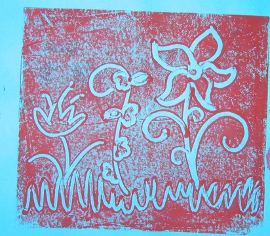Printmaking is different from other art mediums like painting or drawing for several reasons. We will discuss the two main reasons.
The first is that the artist doesn’t create their art by drawing or painting directly onto a canvas or board. Instead the artist uses a different surface (called a matrix and made from things like wood, metal or glass) where they carve or draw onto that surface. Once they have created their design on their surface it is inked up to transfer their design onto paper or fabric.
The second main reason is that prints can be one of a kind or multiples. Since the artist created a matrix with their design they can ink and print it multiple times. Each one is still considered an original work of art (unlike making a photocopy).
There are four main types of print:
1. Relief, which includes woodcuts, linocut and wood engraving. Relief methods are like rubber stamps – the raised area holds the ink. Ink is rolled over the surface and the image is transferred to paper by laying the paper on the inked surface and rubbing the back of the paper with even pressure.
2. Intaglio, which includes drypoint, engraving, and mezzotint, etching and aquatint. In intaglio, the impressions (carved lines) hold the ink and make the image. The ink fills in the crevices and the wet paper absorbs and transfers the color when pressure is applied.
3. Lithography is based on the principle that oil and water do not mix. An oily pencil is used to draw on a flat stone. It is treated and then a water based ink is used to make the print in the areas not resistant.
4. Screen printing is akin to stencils. A fine silk cloth is mounted on a frame (like a screen) and the artist makes a sort of stencil with a type of glue, blocking the ink from coming through certain areas when the ink is forced through with a squeegee.
Show the examples below and comment on the many different varieties of looks that can be achieved with print mediums. Does it look more like drawing or painting?
Make a print! The example below is a simple monoprint made from rolling printing ink on a piece of glass, drawing with your finger and then pressing it onto a piece of paper. A monoprint can be made from any relief print. The difference is only one is created before changes are made to the surface (matrix). There are many other types of prints.

 Women on the Shore, Munch, 1898, colored woodcut.
Women on the Shore, Munch, 1898, colored woodcut.
.jpg)
Jockey, Toulouse-Lautrec, 1899, lithograph.
.jpg)
Whetting the Scythe, Kathe Kollwitz, 1905.

Whaam, Lichtenstein, 1963, silkscreen.

Marilyn, Warhol ,1967, silkscreen.

Les Endermann, George Baselitz, 1982, woodcut.

Saladin, Gustave Dore, 1884, lithograph.

Fuji from Sevenri Beach, Hokusai, 1823, woodcut.
 Welcome to the Water Planet, James Rosenquist, 1987, aquatint.
Welcome to the Water Planet, James Rosenquist, 1987, aquatint.

The Prophet, Nolde, 1912, linocut.

Concentric Bearings, Vija Celmins, 1985, photogravure, aquatint, drypoint and burnishing.

The Omnibus, Mary Cassatt, 1912, aquatint.

Dreaming of her Wedding, Utamaro, 1798.
Fueling Success for Every Student, Every School